|
|
| Specialist Projects |
Heritage Project Contracts is happy to work with all sizes of building contractors to assist them in the redevelopment of heritage buildings and structures across the UK. We have worked with a number of construction companies on prestigious projects undertaking high quality works sympathetic to the building fabric. |
| Manchester Library Reading Room Desks |  |
|
The Grade II* Manchester Central Library building was originally designed by E Vincent Harris and when completed in 1934 was one of the most significant
buildings in Manchester. It has recently been the subject of a four year Transformation programme of works and Heritage Project Contracts was employed by
Laing O'Rourke to undertake a number of specialist conservation projects including the refurbishment of the original library reading room desks. The work
involved the cleaning and repair of the large 16 seat walnut library desks and the replication of new lighting canopies to restore the appearance of the
reading room to its original condition.
|
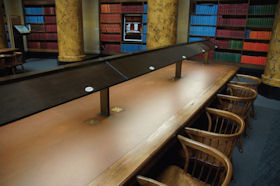
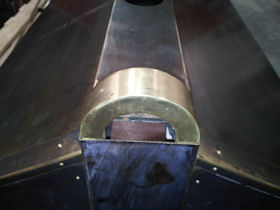 Fourteen of the original lighting 6 seat canopies were missing. HPC manufactured new canopies to exactly replicate the original items from brass and
aluminium sheeting. This was cut, folded and riveted around a steelwork frame with cast brass detailing applied. The canopies were then chemically
patinated to replicate the original deep brown bronze finish.
Fourteen of the original lighting 6 seat canopies were missing. HPC manufactured new canopies to exactly replicate the original items from brass and
aluminium sheeting. This was cut, folded and riveted around a steelwork frame with cast brass detailing applied. The canopies were then chemically
patinated to replicate the original deep brown bronze finish.
|
The tables were cleaned to remove dirt, offensive graffiti marks and old surface coatings. Traditional Linoleum tops were cleaned and refreshed and missing
elements of the timber mouldings were replicated and fitted. The cleaned woodwork was French polished and a protective coating of wax applied.
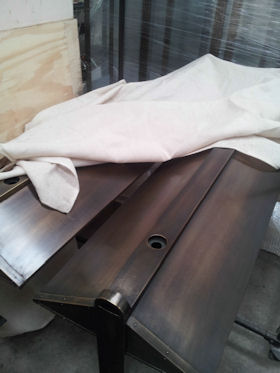
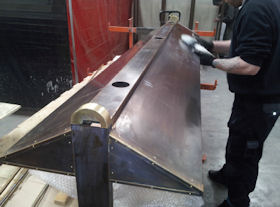
|
|
Works completed - December 2013
Main contractor - Laing O'Rourke
|
| British Medical Association Memorial Entance Gates |  |
|
The British Medical Association sits on the original site of Tavistock House and grounds. After the latter's demolition in 1900, Sir Edwin Lutyens
designed new buildings on the site, originally for the British Theosophical Society between 1911 – 14. These unfinished buildings were acquired by
the BMA in 1923 and Lutyens completed them to form new headquarters in 1925. He was also responsible for the design of the memorial garden and the
Grade II Gates of Remembrance. The gates were erected in memory of the 574 members of the BMA who died in action during WW1.
|

|
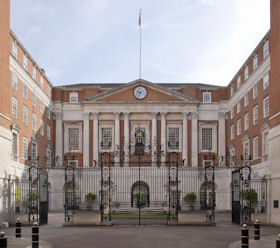
|
Heritage Project Contracts were appointed by the BMA to undertake necessary conservation of the gates in situ. They had previously been restored in
1995, however this had not included the full cleaning of the wrought iron tripartite finial elements and through use, the gates had become damaged
and in need of treatment.
|
|
The works were undertaken whilst the building was in full occupation and it was important that any disruption was minimised. HPC worked with the
client to ensure event use, access and a safe working environment was maintained at all times. The memorial plaques at the centre of the overthrow,
together with the serpent, were removed to a workshop for careful cleaning and re-gilding. The works were undertaken to a very tight programme and
completed in August 2014.
|

|
|
Works completed - August 2014
Main contractor - BMA
|
| Manchester Central Library Specialist Metalwork |  |
|
The Grade II* Manchester Central Library building was originally designed by E Vincent Harris and, when completed in 1934, was one of the most significant
buildings in Manchester. It has recently been the subject of a four year Transformation programme of works and Heritage Project Contracts was employed by
Laing O'Rourke to undertake a number of specialist and innovative projects to improve the serviceability of the building whilst maintaining the character
of the Library. The works included the replication of new handrails to Shakespeare Hall, bespoke floor expansion strips to the floor of the main reading
room, patinated brass conduits, door stops and media screen supports. Each element was individually designed and fabricated before being chemically patinated
to give a deep bronze patina.
|

|
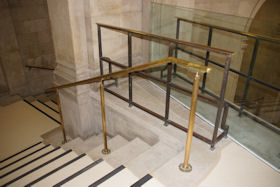
|
Where possible HPC utilised salvaged brass material taken from the building into the new items ensuring maximum retention of original materials.
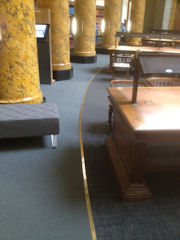
|



|
|
Works completed - June 2014
Main contractor - Laing O'Rourke
|
| 'Sylvie' Engine at Museum of Lincolnshire Life |  |
|
The Museum of Lincolnshire Life houses an extensive collection of industrial and agricultural artefacts from the area, including 'Sylvie', a Ruston Proctor
engine. The engine was for many years used by the volunteers to attract visitors to the Museum. However, over recent years it was not able to be steamed due
to thinning of the original boiler ironwork. A fund was established for her repair, in part due to the extent of original material which is rare in a working
engine. A conservation approach was followed to conserve and display the engine as a static exhibit within the gallery, thus preserving her for future generations
to enjoy.
|
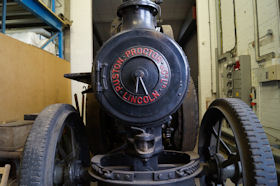
|
Heritage Project Contracts was employed to undertake this sensitive conservation work, preparing 'Sylvie' for display in the Museum. She was carefully
cleaned to remove contaminated grease, dirt layers and corrosion. The surfaces were then protected using a Carnuba wax and synthetic grease coating.
|
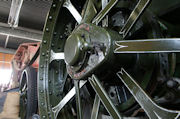
|
The engine was then returned to an improved interpretation display area where it was connected with a drive belt to one of the Museum's threshing
machines. Loose components including boiler side covers, fire bars and fireman's tools were displayed separately next to the engine.
|
|
Works completed - June 2013
Client - Lincolnshire County Council
|
| Manchester City Lamp Posts |  |
|
The Grade I Listed Old Town Hall building in Manchester was constructed in 1877 and was originally externally lit by a number of cast iron lamp
posts with gas-lit lanterns. Over time the majority of these lamps had become damaged and had been replaced with more modern electrical fittings.
As part of the works to the Town Hall Extension the last remaining seven lamp posts,of which two had recently become damaged due to collisions with
motor vehicles, required full refurbishment.
|

|
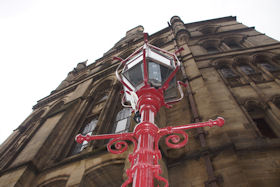
|
Heritage Project Contracts undertook an initial survey on the cast iron posts and the modern lighting heads and developed a programme of work
for the refurbishment works. This included a Listed Building Consent application for approval of the new replica lighting heads with the
Planning Authority and English Heritage.
|
|
Following approvals the posts were removed and taken to HPC's specialist workshops in Shropshire for assessment and repair. Paint analysis
that was carried out revealed that the columns had been re-painted a total of 22 times in varying colours and only recently in their current
black colour. The original paint system was a burnt red colour and this was chosen as the proposed colour for re-instatement.
|

|

|
Existing paint coatings were removed by careful abrasive cleaning to identify the extent of damage, fractures and missing elements, which required
repair and replication. For the posts that were severely damaged, and in a number of components, an internal armature was fitted to provide
additional support to the overall structure.
|
|
Based on archive photographs, the original gas lit heads were replicated in copper, fitted with modern LED lighting and patinated to a deep
bronze colour.
|

|
The completed installation was undertaken in conjunction with the contract works to re-pave the area.
|
|
Works completed - October 2013
Main contractor - Laing O'Rourke
|
| The Radcliffe Camera, Oxford |  |
The Radcliffe Camera building is named after John Radcliffe (1650 - 1714), who funded its construction through a bequest. It was designed by James
Gibbs in a neo-classical style to house the Radcliffe Science library. It was built between 1737 - 1749 and is now part of Oxford University, being
used as a reading room for the Bodleian Library. The building is listed Grade I.

|
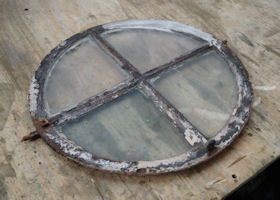 These trial works were undertaken to allow the client to gauge the level of repairs required to the Radcliffe Camera windows. It is intended that
any further works will be of minimal intervention.
These trial works were undertaken to allow the client to gauge the level of repairs required to the Radcliffe Camera windows. It is intended that
any further works will be of minimal intervention.
|
Heritage Project Contracts was appointed by the Oxford University Estates Directorate to undertake trial cleaning and repair works to two large
timber windows and one small circular iron window. The latter was in a poor condition due to heavy corrosion. It required careful reconstruction
with new metal sections.

|
|
Works completed - October 2013
Client - Oxford University Estates Directorate
|
|
|
|

|
|
| Understand |
Develop |
Implement |
|